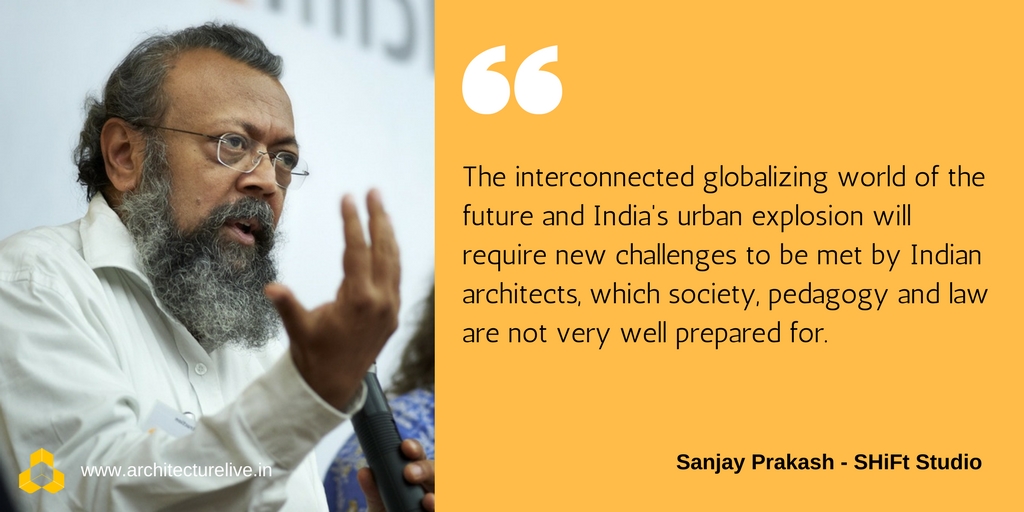Globalisation, changing job profiles, migration, need for affordable housing, artificial intelligence and the advent of new materials and technologies for construction – all of these have set new expectations from architectural practices. We talked to prominent architects in India about the pressures, new skill-sets, and challenges that architects will need to be prepared for. Below, Sanjay Prakash, Principal Consultant at SHiFt Studio, shares his thoughts.
The interconnected globalizing world of the future and India’s urban explosion will require Indian architects to meet new challenges – which society, pedagogy and law are not very well prepared for.
Nowadays, one cannot imagine a major architectural project to be well-designed without extensive collaboration and leadership of technologists, engineers, ecologists, landscape specialists, etc. In this context, our out-dated concept (in the Architects Act, for instance) of making the Architect the captain of the inter-disciplinary team becomes rather obsolete.
Young people who are able to speak the language of the environment, engineering, graphics, quantities, science and art together will be more in demand than the architects, who speak mainly a visual language these days.
Also read Sanjay Prakash’s views on the role and relevance of architects today in the society.
 Sanjay Prakash, B. Arch., A.I.I.A., is an architect with a commitment to energy-conscious architecture, eco-friendly design, people’s participation in planning, music, and production design. Over the years, he has integrated all his work with the practice of new urbanism and sustainability in his professional and personal life.
Sanjay Prakash, B. Arch., A.I.I.A., is an architect with a commitment to energy-conscious architecture, eco-friendly design, people’s participation in planning, music, and production design. Over the years, he has integrated all his work with the practice of new urbanism and sustainability in his professional and personal life.
His area of practice and research over the last 34 years includes passive and low energy architecture and planning, hybrid air-conditioning, autonomous energy and water systems, bamboo, wood and earth construction, community-based design of common property, and computer-aided design. Under his guidance, hundreds of persons have developed capabilities in performing design, conceptual or management work in these areas.
He is Principal Consultant of his design firm, SHiFt: Studio for Habitat Futures (formerly known as Sanjay Prakash & Associates), and was a partner of daat and Studio Plus, firms that predate his current firm. His name and work is mentioned in the twentieth edition of one of the main reference works in architectural history, A History of Architecture by Sir Bannister Fletcher.








2 Responses
Sanjay Prakash ji well stated with indepth analysis. Yes over nineteen professional deciplines ha e to be integrated from concept to realization
Alternative is small individual iconoclastic projects. But can only be created by mazters who have experienced the journey
Undoubtedly, large scale complex projects require collaboration of multiple consultants including the architects for a high quality end result. A building needs to effectively integrate all sorts for service systems such as HVAC, electrical design, lighting, plumbing, building management services etc. which is way beyond the scope of a single person or architect to accomplish by himself/herself. Honestly we cant imagine doing a project without the input of specialist consultants in the construction industry.
However, even when it comes to small scale projects such as a small residence most of the fresh graduates or even young architects seem to lack the basic understanding of many technical aspects of building design. In a curricullum that seems to focus more on sketching and a tendency of young architects to master computer softwares, technical understanding of basic structures, electrical, lighting etc seems to have taken a backseat. The end result is that a so called young licensed architect is not even capable of taking charge of even building a small residence. He might be able to come up with a great vision but what good is it if it cannot be executed to match the vision.
While the future does require us to collaborate with consultants from various disciplines, it should not become an excuse for young architects like me to rely on them so much that we wait to learn things only by experience, especially in a field where experience comes slowly. Learning has to happen proactively. Besides, we can collaborate better only when we understand a thing or two about each and every aspect of building construction.